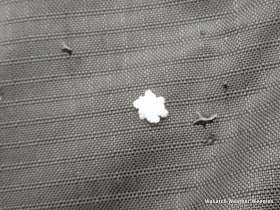If you were out today, you probably saw a few pristine snowflakes, but also plenty of defective ones. Here are a few examples to illustrate the flake diversity. All of these were taken with my el cheapo point-and-click camera over a period of just a few minutes.
First we have two somewhat pristine stellar dendrites. These are Mother Nature's favorite sons as they have experienced little riming and have landed on my thigh without mechanical fracturing.
The next is lightly rimed. You can tell it was a 6 armed snowflake at one time, but as the flake fell, it collected supercooled cloud droplets (i.e., cloud droplets that are colder than 0ºC but haven't yet frozen), which froze on contact and coated the flake to some degree.
Here's another that's moderately rimed. The six arms are barely distinguishable.
There are a number of ways that Mother Nature tortures snowflakes. One is riming, as illustrated above. Another is by smashing them together. Riming typically increases with temperature, although there are other factors that can contribute, and the smashing and mechanical fracturing of snowflakes typically increases with wind speed and turbulence.
Between today and tomorrow we will see a massive escalation of snowflake abuse in the Wasatch Mountains as temperatures and winds increase. At upper elevations, there's going to be lots of defective snowflakes tomorrow (at the lower elevations, you're going to find rain). Listen carefully and you might hear their cries of pain and agony.
Both riming and mechanical fracturing increase the density/water content of snow. You're not going to find the Greatest Snow on Earth in the Wasatch tomorrow. Instead, we're going to see Cascade Concrete. This is going to be a storm that produces a lot of water, but because the snow is so dense, snow totals won't be eye popping. For example, in upper Little Cottonwood the NWS is calling for 2–3 inches of storm water through 4 PM Monday (including what fell today), but only 18–24" of snow.
That high density snow, however, is just what we need for base building in the upper elevations. Unfortunately, snow levels tomorrow will be fairly high tomorrow and may flirt with 8000 feet at times, so the lower elevations won't be as fortunate.




The forecast calls for snow levels to rise tomorrow, and then fall again Sunday night into Monday. Do you think this will allow for a right-side up layer on Monday at least?
ReplyDeleteThe later stage will be right side up, but even a snow snob like me won't thumb their nose at the higher density stuff this year.
Delete